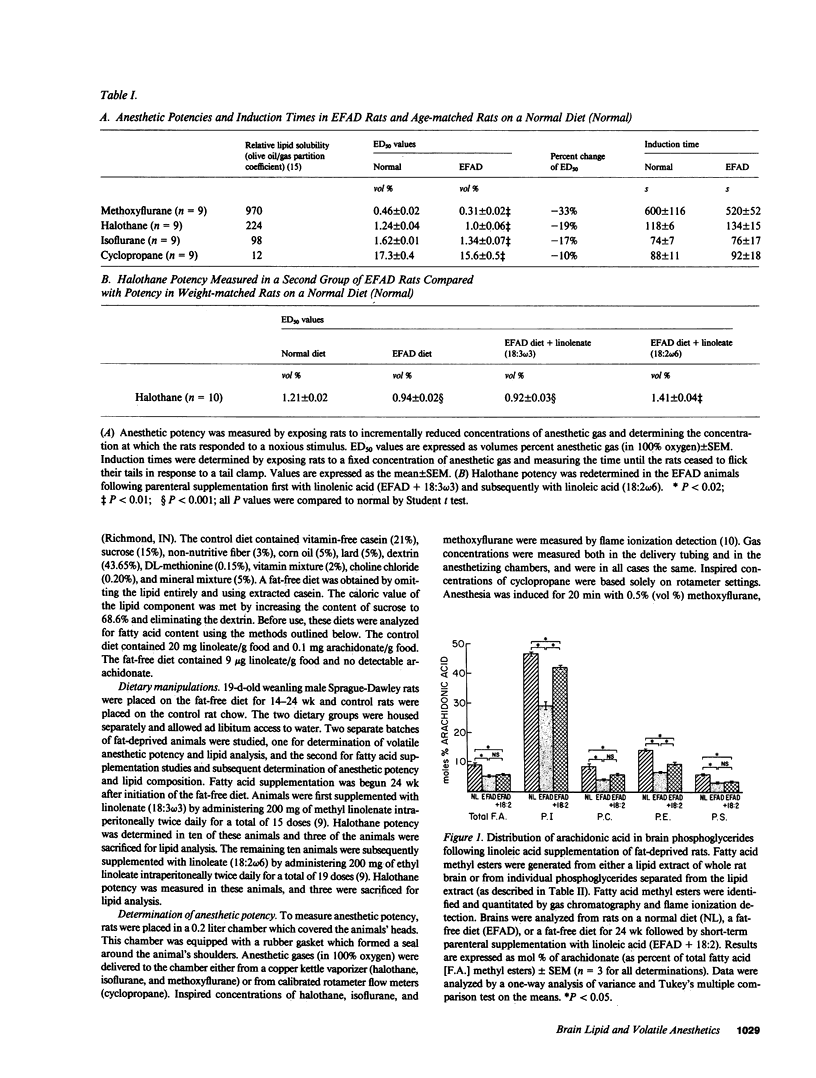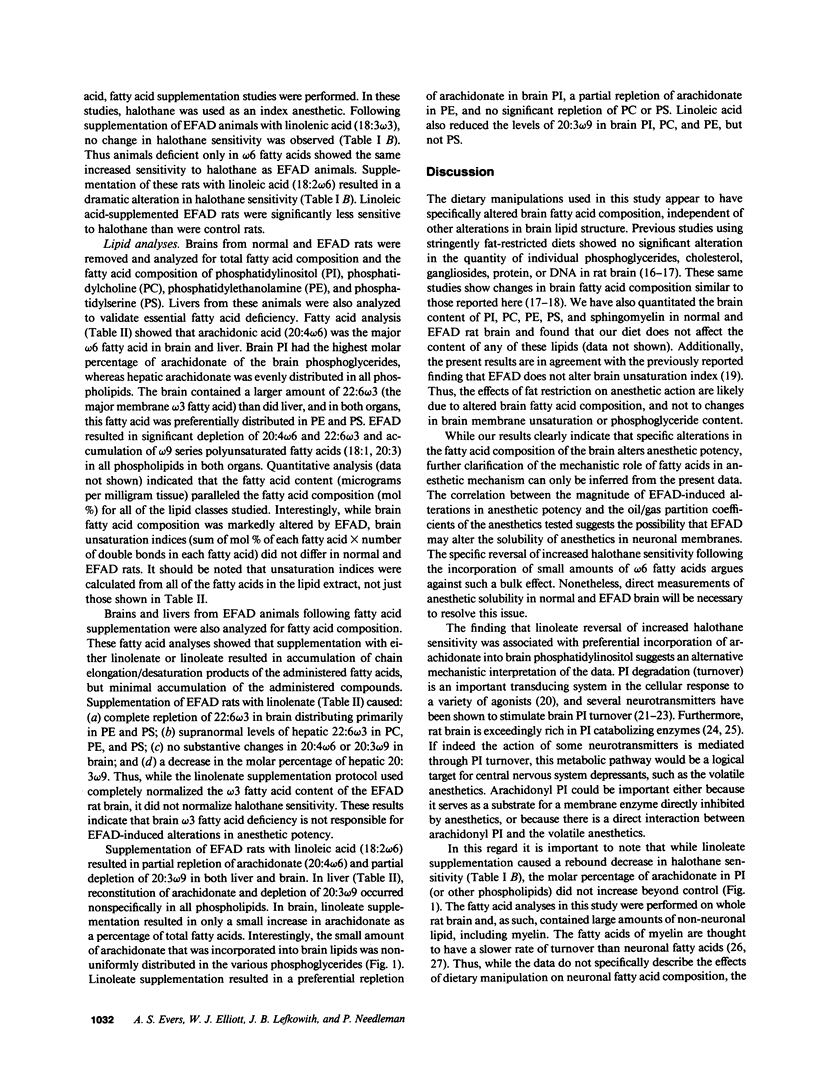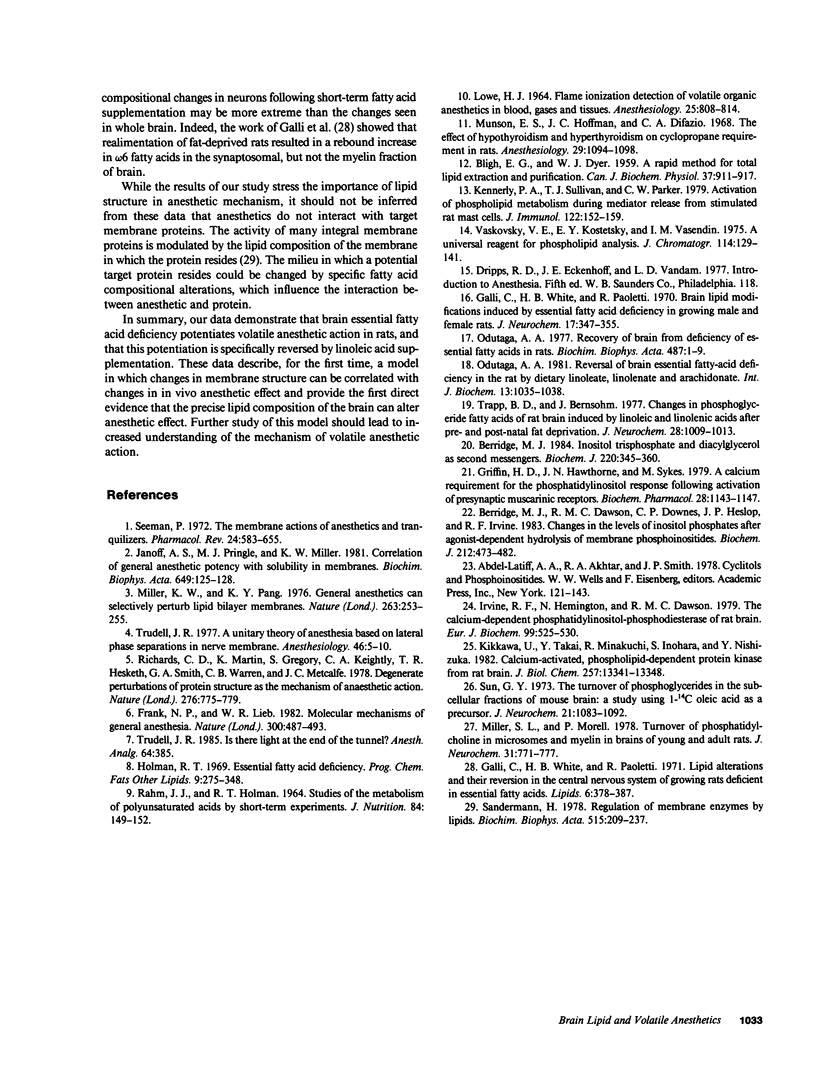Abstract
The molecular mechanism of volatile anesthetic action remains unknown. Attempts to elucidate this mechanism have been complicated by the absence of models in which changes in neuronal cellular properties can be correlated with changes in whole animal anesthetic effect. In this study we describe a model where diet-induced alterations in rat brain fatty acid composition are correlated with alterations in volatile anesthetic potency. Rats maintained on a fat-free diet showed significant depletion of arachidonic acid (20:4 omega 6; 5,8,11,14-eicosatetraenoic acid) and docosahexaenoic acid (22:6 omega 3; 4,7,10,13,16,19,-docosahexaenoic acid) in brain, and a corresponding increase in Mead acid (20: 3 omega 9; 5,8,11-eicosatrienoic acid). These fat-deprived rats were significantly more sensitive to all volatile anesthetics tested than were age-controlled rats on a normal diet. Parenteral supplementation of the fat-deprived animals with linolenic acid (18: 3 omega 3, 9,12,15-octadecatrienoic acid) completely reconstituted the docosahexaenoic acid content of brain without affecting anesthetic sensitivity. In contrast, supplementation of the fat-deprived rats with linoleic acid (18: omega 6; 9,12-octadecadienoic acid) caused a dramatic decrease in anesthetic sensitivity, but only a small change in whole brain arachidonate content. Further analysis revealed that linoleate supplementation of fat-deprived animals resulted in a preferential normalization of the arachidonate content of brain phosphatidylinositol as compared with other brain phosphoglycerides. These results demonstrate for the first time a correlation between changes in membrane composition and anesthetic effect, and indicate that the precise fatty acid composition (perhaps in specific phospholipids) of brain is important in the mechanism of volatile anesthetic action.
Full text
PDF





Selected References
These references are in PubMed. This may not be the complete list of references from this article.
- BLIGH E. G., DYER W. J. A rapid method of total lipid extraction and purification. Can J Biochem Physiol. 1959 Aug;37(8):911–917. doi: 10.1139/o59-099. [DOI] [PubMed] [Google Scholar]
- Berridge M. J., Dawson R. M., Downes C. P., Heslop J. P., Irvine R. F. Changes in the levels of inositol phosphates after agonist-dependent hydrolysis of membrane phosphoinositides. Biochem J. 1983 May 15;212(2):473–482. doi: 10.1042/bj2120473. [DOI] [PMC free article] [PubMed] [Google Scholar]
- Berridge M. J. Inositol trisphosphate and diacylglycerol as second messengers. Biochem J. 1984 Jun 1;220(2):345–360. doi: 10.1042/bj2200345. [DOI] [PMC free article] [PubMed] [Google Scholar]
- Franks N. P., Lieb W. R. Molecular mechanisms of general anaesthesia. Nature. 1982 Dec 9;300(5892):487–493. doi: 10.1038/300487a0. [DOI] [PubMed] [Google Scholar]
- Galli C., White H. B., Jr, Paoletti R. Brain lipid modifications induced by essential fatty acid deficiency in growing male and female rats. J Neurochem. 1970 Mar;17(3):347–355. doi: 10.1111/j.1471-4159.1970.tb02221.x. [DOI] [PubMed] [Google Scholar]
- Galli C., White H. B., Jr, Paoletti R. Lipid alterations and their reversion in the central nervous system of growing rats deficient in essential fatty acids. Lipids. 1971 Jun;6(6):378–387. doi: 10.1007/BF02531374. [DOI] [PubMed] [Google Scholar]
- Griffin H. D., Hawthorne J. N., Sykes M., Orlacchio A. A calcium requirement for the phosphatidylinositol response following activation of presynaptic muscarinic receptors. Biochem Pharmacol. 1979 Apr 1;28(7):1143–1147. doi: 10.1016/0006-2952(79)90320-4. [DOI] [PubMed] [Google Scholar]
- Irvine R. F., Hemington N., Dawson R. M. The calcium-dependent phosphatidylinositol-phosphodiesterase of rat brain. Mechanisms of suppression and stimulation. Eur J Biochem. 1979 Sep;99(3):525–530. doi: 10.1111/j.1432-1033.1979.tb13284.x. [DOI] [PubMed] [Google Scholar]
- Janoff A. S., Pringle M. J., Miller K. W. Correlation of general anesthetic potency with solubility in membranes. Biochim Biophys Acta. 1981 Nov 20;649(1):125–128. doi: 10.1016/0005-2736(81)90017-1. [DOI] [PubMed] [Google Scholar]
- Kennerly D. A., Sullivan T. J., Parker C. W. Activation of phospholipid metabolism during mediator release from stimulated rat mast cells. J Immunol. 1979 Jan;122(1):152–159. [PubMed] [Google Scholar]
- Kikkawa U., Takai Y., Minakuchi R., Inohara S., Nishizuka Y. Calcium-activated, phospholipid-dependent protein kinase from rat brain. Subcellular distribution, purification, and properties. J Biol Chem. 1982 Nov 25;257(22):13341–13348. [PubMed] [Google Scholar]
- LOWE H. J. FLAME IONIZATION DETECTION OF VOLATILE ORGANIC ANESTHETICS IN BLOOD, GASES AND TISSUES. Anesthesiology. 1964 Nov-Dec;25:808–814. doi: 10.1097/00000542-196411000-00012. [DOI] [PubMed] [Google Scholar]
- Miller K. W., Pang K. Y. General anaesthetics can selectively perturb lipid bilayer membranes. Nature. 1976 Sep 16;263(5574):253–255. doi: 10.1038/263253a0. [DOI] [PubMed] [Google Scholar]
- Miller S. L., Morell P. Turnover of phosphatidylcholine in microsomes and myelin in brains of young and adult rats. J Neurochem. 1978 Oct;31(4):771–777. doi: 10.1111/j.1471-4159.1978.tb00109.x. [DOI] [PubMed] [Google Scholar]
- Munson E. S., Hoffman J. C., DiFazio C. A. The effects of acute hypothyroidism and hyperthyroidism on cyclopropane requirement (MAC) in rats. Anesthesiology. 1968 Nov-Dec;29(6):1094–1098. doi: 10.1097/00000542-196811000-00003. [DOI] [PubMed] [Google Scholar]
- Odutuga A. A. Recovery of brain from deficiency of essential fatty acids in rats. Biochim Biophys Acta. 1977 Apr 26;487(1):1–9. doi: 10.1016/0005-2760(77)90038-8. [DOI] [PubMed] [Google Scholar]
- Odutuga A. A. Reversal of brain essential fatty-acid deficiency in the rat by dietary linoleate, linolenate and arachidonate. Int J Biochem. 1981;13(9):1035–1038. doi: 10.1016/0020-711x(81)90010-0. [DOI] [PubMed] [Google Scholar]
- RAHM J. J., HOLMAN R. T. STUDIES OF THE METABOLISM OF POLYUNSATURATED ACIDS BY SHORT-TERM EXPERIMENTS. J Nutr. 1964 Oct;84:149–154. doi: 10.1093/jn/84.2.149. [DOI] [PubMed] [Google Scholar]
- Richards C. D., Martin K., Gregory S., Keightley C. A., Hesketh T. R., Smith G. A., Warren G. B., Metcalfe J. C. Degenerate perturbations of protein structure as the mechanism of anaesthetic action. Nature. 1978 Dec 21;276(5690):775–779. doi: 10.1038/276775a0. [DOI] [PubMed] [Google Scholar]
- Sandermann H., Jr Regulation of membrane enzymes by lipids. Biochim Biophys Acta. 1978 Sep 29;515(3):209–237. doi: 10.1016/0304-4157(78)90015-1. [DOI] [PubMed] [Google Scholar]
- Seeman P. The membrane actions of anesthetics and tranquilizers. Pharmacol Rev. 1972 Dec;24(4):583–655. [PubMed] [Google Scholar]
- Sun G. Y. The turnover of phosphoglycerides in the subcellular fractions of mouse brain: a study using (1-14C)oleic acid as precursor. J Neurochem. 1973 Nov;21(5):1083–1092. doi: 10.1111/j.1471-4159.1973.tb07562.x. [DOI] [PubMed] [Google Scholar]
- Trapp B. D., Bernsohn J. Changes in phosphoglyceride fatty acids of rat brain induced by linoleic and linolenic acids after pre- and post-natal fat deprivation. J Neurochem. 1977 May;28(5):1009–1013. doi: 10.1111/j.1471-4159.1977.tb10663.x. [DOI] [PubMed] [Google Scholar]
- Trudell J. R. A unitary theory of anesthesia based on lateral phase separations in nerve membranes. Anesthesiology. 1977 Jan;46(1):5–10. doi: 10.1097/00000542-197701000-00003. [DOI] [PubMed] [Google Scholar]
- Trudell J. R. Is there light at the end of the tunnel? Anesth Analg. 1985 Apr;64(4):385–385. doi: 10.1213/00000539-198504000-00001. [DOI] [PubMed] [Google Scholar]
- Vaskovsky V. E., Kostetsky E. Y., Vasendin I. M. A universal reagent for phospholipid analysis. J Chromatogr. 1975 Nov 12;114(1):129–141. doi: 10.1016/s0021-9673(00)85249-8. [DOI] [PubMed] [Google Scholar]


